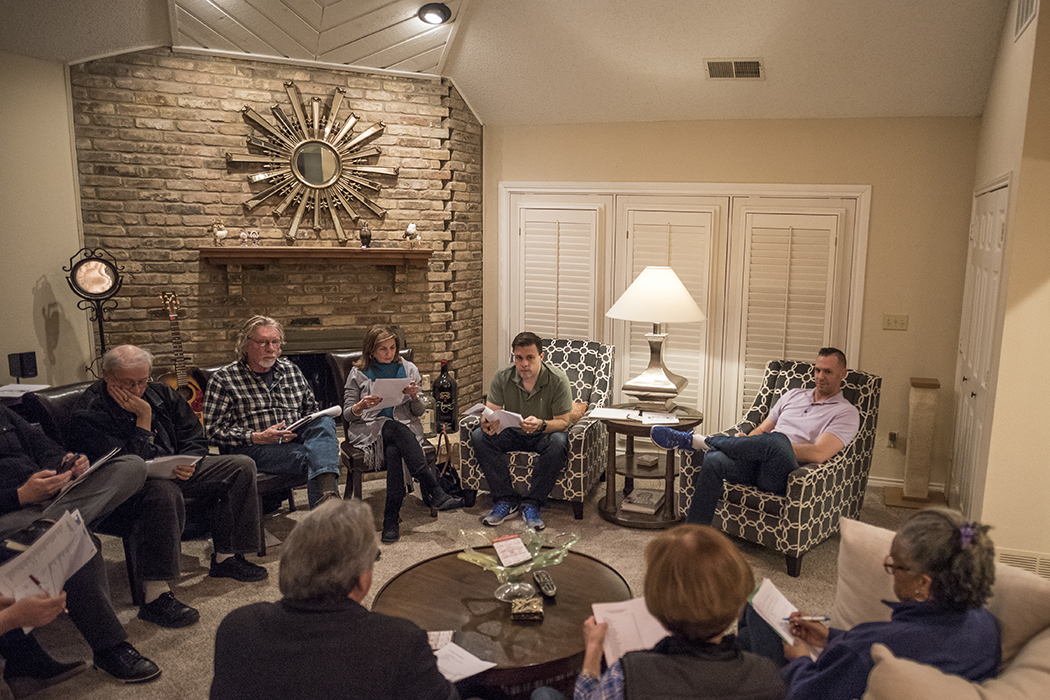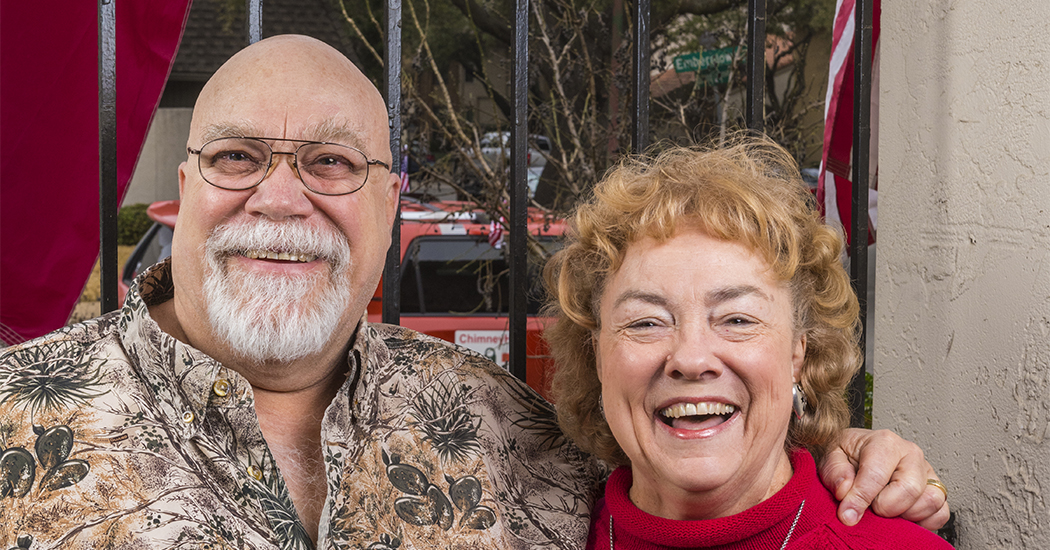
Homeowners in north Lake Highlands meet regularly to strategize; they won’t back down when it comes to personal-and-property protection and bettering surrounding violent, non-compliant properties. (Photo by Danny Fulgencio).
Lessons from the Northeast
Enclaves of north Lake Highlands remain relatively secure in an area of Dallas gangsters have dubbed “Northghanistan” for its drug-and-gang related carnage over a span of more than two decades. Excluding the occasional sensational news story (a WFAA broadcast brought that name — “Northghanistan” — to the headlines) or rare personal experiences with crime, homeowners enjoy shelter from close-proximity chaos. Still, you won’t find them — the residents of Chimney Hill, Jackson Branch, Country Meadow, ChimneyHill Townhomes, etc. — resting on laurels or turning a blind eye to what is happening around them.
Observe and report
Admire Richland College’s lovely landscape: rolling green fields, a tree-and-horticulture center, wooden bridges over duck and turtle-inhabited ponds; a gang of domineering geese patrols campus. But don’t dawdle. To stall along this stretch of Abrams north of I-635 is to be panhandled or solicited.
Across the street, one cannot ignore the sprawling scarred acreage, once home to Hearthwood condominiums, now bordered by barbed wire and plagued by memories of fallen firefighter Stan Wilson, who died during the building’s 2013 blaze. Next door, ChimneyHill Townhomes draws little consideration, or could be dismissed as another dense, crime-ridden multifamily district.
Any such assumption would be rooted in reality, but wrong. Most of northern Lake Highlands’ denser areas — apartments, condos and townhomes — are problematic like that.
Less than 2 miles east, the Forest-Audelia vicinity suffers some of our city’s highest crime rates. And just a mile north of Richland, the Greenville-I-635 area also has made the Dallas police department’s top-10 list for violent crimes a time or two.
Northeast Division commanders over the years have explained that the unusually high density in northern Lake Highlands contributes to those lofty crime numbers.
In HOA and crime watch meetings, or during ride-along interviews, police reiterate that (their own work notwithstanding) the leading factor in preventing crime is a strong, involved neighborhood coalition. Neither citizen patrols nor more-official Volunteer In Patrol members act on suspicious situations, police say, but rather offer additional eyes and ears. They call cops when a challenge or potential problem emerges.
Dallas Dupree inherited the crime watch efforts for ChimneyHill Townhomes 16 years ago. But this neighborhood has had a strong group from the onset, Dallas’ wife, Peggy, says.

Dallas Dupree and wife, Peggy, are charming; just don’t mess with ChimneyHill. (Photo by Danny Fulgencio).
Dupree pulls out a thick binder in which crimes are recorded and color coded. It contains more than 20 year’s worth of data. “If it’s red, it’s bad, like an attack,” he says.
In 2013, a man was murdered in his driveway when he confronted someone attempting to steal his car. “That happened right here on our street. It was the worst year I’ve seen,” Dupree says, pointing to a few other red-coded incidents indicating assaults and attempted rapes.
Extra patrols, officers on horseback, even under-cover cops on bikes came to check on ChimneyHill during the following weeks and months, Peggy says, owing the response to good communications between crime watch and the force.
Even in times of miniscule mischief, Dallas Dupree remains focused on crimes, because, he says, “If the crime happened to you, if your car window is broken, if your property is stolen or vandalized, you do not care about the statistics or data. You are hurt, injured, violated — it’s the thing I always remember.”
In ChimneyHill since its onset, Peggy, a former Lewisville city council member, recalls sitting in the bleachers when ground broke on Richland College. The ChimneyHill Townhomes were so chic in the ‘70s that the development won several design awards, according to an archived Dallas Morning News story.
And when the TV show “Dallas” was a big deal, the filming crew, actors, and even illustrious scoundrel J.R. Ewing (Larry Hagman), one summer, recorded several scenes at ChimneyHill, Peggy says (Dallas nods, either to corroborate or to indicate he’s heard the story. Many times).
“See J.R. was having an affair with a woman who lived here in these townhomes,” Peggy says. “All summer the crew, the little girl Lucy and the extras would be in and out and hanging around the neighborhood — Lucy liked to skate — and J.R. would slink in, sneaking into his mistress’ place.”
Dallas Cowboys lived here too, she adds “Randy White was our crime watch chair for a while.”
Because the practice field was right down the street, Dallas adds.
Rolling down the street in his bold red truck, Dallas stops for dogs. Peggy offers treats to pups out this sunny, chilly Friday afternoon, chatting up owners.
Neighborhood canines go nuts when they see Dallas’ bold red truck — “ChimneyHill Crime Watch Patrol” magnet on its side door, an American Flag fluttering from the rooftop — because to them it means snacks.
“We make these rounds about three times a day,” Dallas says of his meandering cruise past 405 homes. His crime watch team includes some 25 other residents. If someone doesn’t have a ride partner, Peggy usually hops aboard. She and her friends have acquired smart nicknames. “Rattler” is Peggy. Her friend Caroline is “Agent Cobra.”
They know crime is critical, and they are dead-set on preventing it, but they never take themselves too seriously.
“A lot of this is just talking to a lot of people,” Peggy says. Getting to know your neighbors, their cars and dogs … it’s fun, you make friends, you have a safer place to live.”
An ‘oasis’
ChimneyHill Townhomes is “an oasis,” said the community police officer at a December 2016 meeting— smack-dab in the middle of low-income, high-crime apartments, she explained, it isn’t easy.
But, ChimneyHill alone is not the success story.
They have accomplished virtual tranquility thanks in large part to the help from community police, Dallas Dupree repeats. “I just cannot say enough about how great they have been to this neighborhood,” he says.
They also owe this regional concord to a strong, tenacious and savvy collaboration of crime fighting citizens throughout northern Lake Highlands — folks who understand the importance of tackling issues both big and small; participation among northern Lake Highlands shareholders is robust, their reasoning sound.
In 2016, for instance, a group of homeowners in northern Lake Highlands, across from ChimneyHill Townhomes, behind Richland, raised a ruckus about an overflowing clothing donation bin in a retail center at the corner of I-635 and Abrams. Nobody clamoring for the bin’s removal could actually see the thing from home (likely an attractive, spacious house amid towering, deeply rooted oak trees).
Overkill that it might have seemed — especially considering that the bin sat in an area prone to problems not limited to homelessness, begging, prostitution, drug dealing and major violence, which seemingly are worthier of attention. But neighborhood veterans understand nitpicking is essential to their area’s enduring welfare.
“It is important to do what we can to clean things up,” explained Jackson Meadows’ Chuck Stegman, back when he was leading the bin-removal effort. The unkempt box was a small eyesore but symbolic of bigger issues including aggressive panhandlers and loitering on private properties, he explained.
Many of the same people pitched a justified fit when a local restaurant’s sewage started to overflow. And when the City of Dallas did not immediately respond, neighbors raised their voices (actual and virtual, that is, on social media, and they contacted the press), bringing the district’s councilman (and a news van) to the scene within the next 24 hours.
Aesthetic and olfactory assaults can blossom into bigger crime, the theory goes, so diligence is required. It is an important part of bigger-picture security, prosperity and quality of life, Stegman says.
This “broken window theory” — the belief that shattered glass, litter, loitering or disrepair signifies an unstable environment and invites criminality — drives Stegman and leaders of nearby neighborhood HOAs to pay attention to detail, to let nothing slide, to make noise.
They are the proverbial ‘squeaky wheel,’ and they usually procure the grease they require.
Activists like Stegman and Dupree have managed to form tight relationships with Dallas’ code-enforcement officers and community prosecutors, which has resulted in cleaner, safer environments, reduced panhandling and the prevention of any re-zoning that could bring potential harm to the neighborhoods.
Those prosecutors have implemented community courts just down the street from ChimneyHill (this allows panhandlers, loiterers and other code breakers to make it to court when they are cited, and the court provides opportunities for assistance if a person desires it).
Payoff
Efforts have drawn the attention of at least one respected developer, Diane Cheatham, who is building a modern, unique, environmentally sustainable subdivision at the edge of Abrams and the I-635. She was awestruck observing vigilant neighbors from the area who meet regularly at the ChimneyHill Townhomes clubhouse.
“I’ve attended neighborhood meetings over there and have been blown-away impressed,” says Cheatham, whose Urban Commons is under construction, already sparking national interest.
“They have an active group that is quietly, constantly keeping this whole area at the forefront when it comes to development, security and growth,” Cheatham says. “I think Urban Commons will help to continue to elevate and transform the area. I became a believer a long time ago in the way [beautification] can lift everything around it.”





